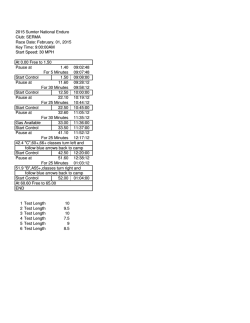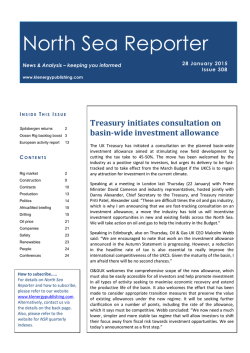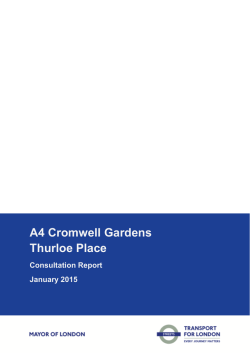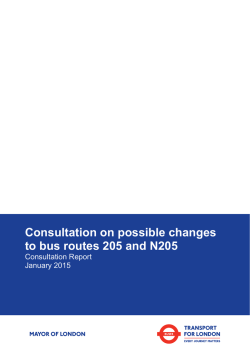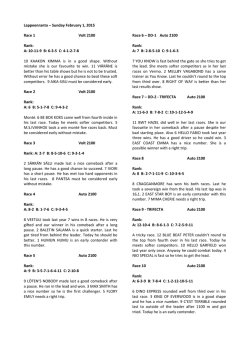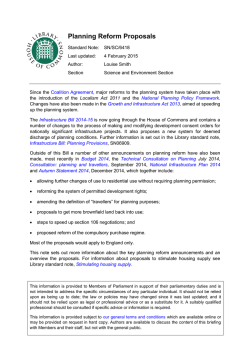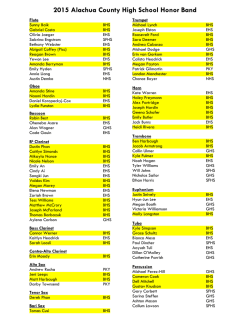
English Housing Survey - UK Statistics Authority
UK Statistics Authority 1 Drummond Gate London SW1V 2QQ Telephone: E-mail: Website: 0845 604 1857 [email protected] www.statisticsauthority.gov.uk Chair of the UK Statistics Authority, Sir Andrew Dilnot CBE Rt Hon John Healey MP House of Commons London SW1A 0AA 30 January 2015 Dear John, ENGLISH HOUSING SURVEY Thank you for your letter dated 21 January 2015, regarding the Department for Communities and Local Government’s (DCLG) recently launched Consultation on the future shape of the English Housing Survey. It is the Authority’s role to promote and safeguard the production of official statistics which serve the public good, and my staff have been monitoring the Department’s proposed changes to the English Housing Survey closely. The National Statistician, John Pullinger, has responded to the consultation today on behalf of the Authority and I have attached a copy of his response overleaf. As the National Statistician set out in his letter, the Authority encourages DCLG to consider very carefully the implications any pause to the survey would have for the long-term evidence base for housing in England. I am copying this letter to the Secretary of State for Communities and Local Government, Rt Hon Eric Pickles MP, and to John Pullinger. Yours sincerely Sir Andrew Dilnot CBE UK Statistics Authority 1 Drummond Gate London SW1V 2QQ Tel: (+44) 0207 592 8663 E-mail: [email protected] www.statisticsauthority.gov.uk/national-statistician John Pullinger CB CStat | National Statistician Sir Bob Kerslake Permanent Secretary Department for Communities and Local Government 2 Marsham Street London 30 January 2015 Dear Bob I am writing regarding the Consultation on the future shape of the English Housing Survey, which the Department for Communities and Local Government (DCLG) launched on 21 January 2015. The consultation seeks views on how DCLG might improve the survey; and, specifically, on proposals to pause the survey for one year in 2015/16, and/or run the survey on a biennial basis. It also seeks advice on the value the survey currently provides to users. The attached annex sets out some specific and significant uses of this survey, as well as the implications of any pause or transition to a biennial survey. I also wanted to take this opportunity to set out my overarching thoughts on this matter. The English Housing Survey (EHS) and its predecessor surveys have formed key parts of a core evidence base for housing and other policies since the 1980s. Uniquely, the Survey links information collected from households with information on the fabric and condition of their home, which no other survey does. It is the only data source where residents’ characteristics can be brought together with data such as housing tenure, a household’s housing aspirations, and the condition of the housing stock. The EHS is used extensively across government and beyond and is a public good of national importance. I recognise, of course, the constraints that exist on public sector finances, but at a time of heightened interest and rapid change in the housing market, I would urge the Department to consider most carefully the implications any pause to the Survey would have for the long-term evidence base for housing in England. If there is anything I can do to help explore possible options, please do not hesitate to ask your officials to contact me. I am copying this letter to the team responsible for the consultation. Yours sincerely, John Pullinger Annex A Uses of the survey The English Housing Survey (EHS) is used extensively across government and beyond. It has played a critical role in developing and delivering a range of housing policies including, for example, the Right to Buy, regulation of the private rented sector, fire prevention initiatives, and the reform of social housing allocation policies. Data from the EHS currently provides the only source of information about the risks to health from housing across England. It is also a key source for analysing the extent of over-crowding and underoccupation, and policies designed to address such issues. The Survey is currently used to produce annual estimates of fuel poverty in England, and will remain the prime source of information to monitor progress against the new target. Results are also used where information is needed on physical characteristics of household properties, and it is the main evidence on which discussions around the Winter Fuel Payment are based. Current uses also include the compilation of UK measures of inflation. The Survey is used in the derivation of annual dwelling stock weights used in the compilation of the Index of Private Housing Rental Prices (IPHRP) and the owner occupied housing (OOH) component of CPIH. In addition data are used to weight the Private Rented Property component that forms part of the CPI, CPIH, RPI, RPIJ (and other variants of the indices). In addition, the EHS is used in modelling the broad age of properties in the Census. More widely, the EHS has an extensive range of external users, including local authorities, academics, charities, commercial companies, and the general public. Typical local authority uses include utilising EHS data to produce their housing allocations, tenancy policies or housing needs assessments. Implications of pausing the English Housing Survey for one year in 2015-16 and/or running the survey on a biennial basis are possible approaches to deliver cost savings. A pause or shift to a biennial survey would undermine the production of up-to-date information on both housing circumstances and the condition of stock. Similarly, a pause or shift to a biennial survey might mean that it would no longer be possible to produce a number of key statistics, including time series on the profile of housing stock, up-to-date estimates of the extent of over-crowding and under-occupation, conformity with dwelling safety standards, the extent of fuel poverty, and energy efficiency standards. This is because data are currently combined across consecutive survey years in order to produce sufficient sample sizes (a consequence of previous cost-saving measures). Unless sample sizes are increased, with consequent additional costs, a biennial survey would substantially reduce the accuracy and timeliness of results, consequently reducing the Survey’s value to decision makers. The complex nature of data collection under the EHS means that reporting on fuel poverty is currently lagged by approximately 18 months. A decision not to run the Survey in 2015/16 will mean that in 2018, the best information available on fuel poverty will by then be three years out of date. The UK Statistics Authority will provide a more detailed technical note on the implications of the proposals set out in the consultation before the end of the consultation period.
© Copyright 2025
